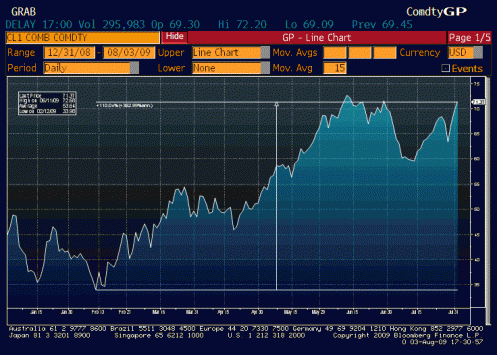
Moves in the oil markets are most closely watched after prices surged to their highest levels since July 2015 on Monday. That rise followed a political crackdown in Saudi Arabia that began during the weekend.
Oil prices slightly declined across the boards Tuesday morning after settling higher by some 3 percent on Monday. Brent crude futures lost 0.25 percent to trade at $64.11.
The rally in crude has inevitably led to talk of just how much further oil can rise, with analysts at Bank of America Merrill Lynch saying on Monday it was possible Brent could see a “cyclical peak” of $75 a barrel in the near future.
While markets may overshoot in the short run, prices for oil contracts for delivery far in the future remain firmly rooted closer to $55 a barrel, suggesting the market is not yet prepared to buy into the rally outright.
Tensions in the region will need to be factored going forward. Volatility indices stateside, which touched their lowest levels this year last week, are unlikely to remain low if crude oil prices continue to push higher quickly.
The rally in oil prices has coincided with a cyclical upturn in the global economy. The rising price of crude reflects the success of Opec’s output cuts to booming demand as the world enjoys near-synchronised economic growth.
Brent crude hit a two-year high of $64.05 a barrel on Monday, taking gains since June to more than 40 per cent and defying those who argued oil would be capped below $60 this year by higher output from the US shale industry.
But higher crude prices at the prompt have not been matched by a similar run up in longer dated prices. If longer-dated prices reached even $60, US oil output will likely start growing again at an annual rate of more than 1m barrels a day — more than 50 per cent higher than they currently forecast.
- Read more: Bear Market in Oil May Last Another Decade
Other market analysts also have said that $70 a barrel has become a real possibility, with Opec’s members happy to reap higher short-term revenues after oil’s painful three-year downturn, despite the threat of rising prices encouraging a new wave of competing supply.
Both fundamental data and an improvement in trader sentiment act as strong support for a continued test of the upside for oil prices, according to analysts at Standard Chartered.
Hedge funds raised outright bets on higher Brent prices to a record last week, holding paper contracts equivalent to almost 600m barrels.
The shift in short-term sentiment has been remarkable. At a major oil conference in London three weeks ago not one panellist or major attendee was seriously focused on oil reaching $70 a barrel. Oil prices have been in a decided uptrend, climbing to the best levels in more than two years on Friday, partly on hopes this year’s Organization of the Petroleum Exporting Countries production-cap deal will be extended, perhaps through 2018. OPEC meets at the end of the month to make a decision on extending the global production agreement.
Saudi Arabia — the largest producer in Opec — is also in focus. A raising tensions in a country responsible for roughly one in every nine crude barrels pumped globally is definitely the primary factor for the oil price direction in the short term.



































